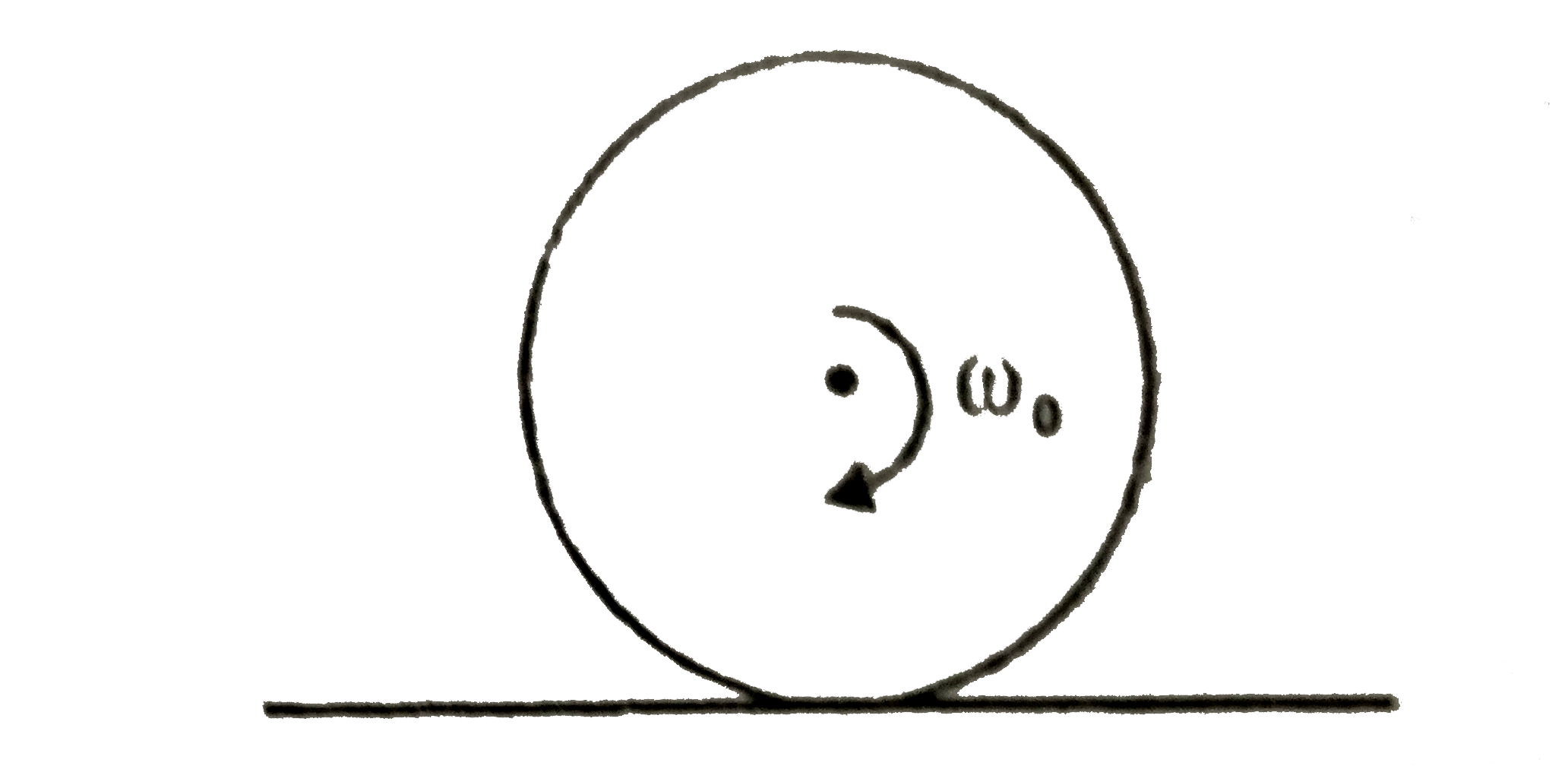Two discs of moments of inertia I1andI2 about their respective axes (normal to the disc and passing through the centre), and rotating with angular speed ω1andω2 are brought into contact face to face with their axes of rotation coincident . What is the angular speed of the two-disc system ?
To solve the problem of finding the angular speed of the two-disc system when two discs are brought into contact, we can follow these steps:
Step 1: Understand the System
We have two discs, Disc 1 and Disc 2, with moments of inertia I1 and I2 respectively. They are rotating with angular speeds ω1 and ω2.
Step 2: Calculate Initial Angular Momentum
The angular momentum L of a rotating body is given by the formula:
L=I⋅ω
Thus, the initial angular momentum of Disc 1 is:
L1=I1⋅ω1
And for Disc 2:
L2=I2⋅ω2
The total initial angular momentum of the system before they come into contact is:
Linitial=L1+L2=I1⋅ω1+I2⋅ω2
Step 3: Determine Final Angular Momentum
When the two discs come into contact, they will rotate together with a common angular speed ω. The total moment of inertia of the combined system is:
Ifinal=I1+I2
The final angular momentum of the system can be expressed as:
Lfinal=Ifinal⋅ω=(I1+I2)⋅ω
Step 4: Apply Conservation of Angular Momentum
According to the principle of conservation of angular momentum, the total initial angular momentum must equal the total final angular momentum:
Linitial=Lfinal
Substituting the expressions we derived:
I1⋅ω1+I2⋅ω2=(I1+I2)⋅ω
Step 5: Solve for the Final Angular Speed ω
Rearranging the equation to solve for ω:
ω=I1⋅ω1+I2⋅ω2I1+I2
Final Result
The angular speed of the two-disc system after they come into contact is:
ω=I1⋅ω1+I2⋅ω2I1+I2
We have two discs, Disc 1 and Disc 2, with moments of inertia I1 and I2 respectively. They are rotating with angular speeds ω1 and ω2.
The angular momentum L of a rotating body is given by the formula:
L=I⋅ω
Thus, the initial angular momentum of Disc 1 is:
L1=I1⋅ω1
And for Disc 2:
L2=I2⋅ω2
The total initial angular momentum of the system before they come into contact is:
Linitial=L1+L2=I1⋅ω1+I2⋅ω2
When the two discs come into contact, they will rotate together with a common angular speed ω. The total moment of inertia of the combined system is:
Ifinal=I1+I2
The final angular momentum of the system can be expressed as:
Lfinal=Ifinal⋅ω=(I1+I2)⋅ω
According to the principle of conservation of angular momentum, the total initial angular momentum must equal the total final angular momentum:
Linitial=Lfinal
Substituting the expressions we derived:
I1⋅ω1+I2⋅ω2=(I1+I2)⋅ω
Rearranging the equation to solve for ω:
ω=I1⋅ω1+I2⋅ω2I1+I2
The angular speed of the two-disc system after they come into contact is:
ω=I1⋅ω1+I2⋅ω2I1+I2
Topper's Solved these Questions
- SYSTEMS OF PARTICLES AND ROTATIONAL MOTIONBOOK - NCERT ENGLISHCHAPTER - SYSTEMS OF PARTICLES AND ROTATIONAL MOTIONEXERCISE - EXERCISE
33 Videos
- PHYSICAL WORLD BOOK - NCERT ENGLISHCHAPTER - PHYSICAL WORLD EXERCISE - EXERCISE
16 Videos
- THERMAL PROPERTIES OF MATTERBOOK - NCERT ENGLISHCHAPTER - THERMAL PROPERTIES OF MATTEREXERCISE - EXERCISE
22 Videos
Similar Questions
Two discs of same moment of inertia rotating their regular axis passing through centre and perpendicular to the plane of disc with angular velocities ω1 and ω2. They are brought into contact face to the face coinciding the axis of rotation. The expression for loss of enregy during this process is :
View SolutionTwo discs of same moment of inertia rotating about their regular axis passing through centre and perpendicular to the plane of disc with angular velocities ω1 and ω2. They are brought into contact face to face coinciding the axis of rotation. The expression for loss of energy during this process is
View Solution
Knowledge Check
Two discs of moments of inertia I1 and I2 about their respective axes (normal to the disc and passing through the centre), and rotating with angular speed ω1 and ω2 are brought into contact face to face with their axes of rotation coincident. What is the loss in kinetic energy of the system in the process?
AI1I2(ω1−ω2)22(I1+I2)BI1I2(ω1−ω2)22(I1+I2)CI1I2(ω1+ω2)2I1−I2DI1I2(ω1+ω2)22(I1−I2)Two discs of moments of inertia I1 and I2 about their respective axes , rotating with angular frequencies ω1 and ω2 respectively, are brought into contact face to face with their axes of rotation coincident. The angular frequency of the composite disc will be
Aa. I1ω1+I1ω2I1+I2Bb. I2ω1+I1ω2I1+I2Cc. I1ω1−I2ω2I1−I2Dd. I2ω1−I1ω2I1−I2
If two disc of moment of inertia l1 and l2 rotating about collinear axis passing through their centres of mass and perpendicular to their plane with angular speeds ω1 and ω2 respectively in opposite directions are made to rotate combinedly along same axis, then the magnitude of angular velocity of the system is
View SolutionTwo discs, each having moment of inertia 5kgm2. about its central axis, rotating with speeds 10rads−1 and 20rads−1, are brought in contact face to face with their axes of rotation coincided. The loss of kinetic energy in the process is
View SolutionFigure shows two cylinders of radii r1andr2 having moments of inertia I1andI2 about their respective axes. Initially the cylinders rotate about their axes with angular speed ω1andω2 as shown in the figure. The cylinders are moved closer to touch each other keeping the axes parallel. The cylinders first slip over each other at the contact but the slipping finally ceases due to the friction between them. Find the angular speeds of the cylinders after the slipping ceases.

View SolutionA disc of mass m and radius R rotating with angular speed ω0 is placed on a rough surface (co-officient of friction =μ). Then

View SolutionTwo discs of moment of inertia I1 and I2 and angular speeds ω1 and ω2 are rotating along the collinear axes passing through their center of mass and perpendicular to their plane. If the two are made to rotate combindly along the same axis the rotational K.E. of system will be
View SolutionTwo discs A and B are in contact and rotating with angular velocity with angular velocities ω1andω2 respectively as shown. If there is no slipping between the discs, then

View Solution
